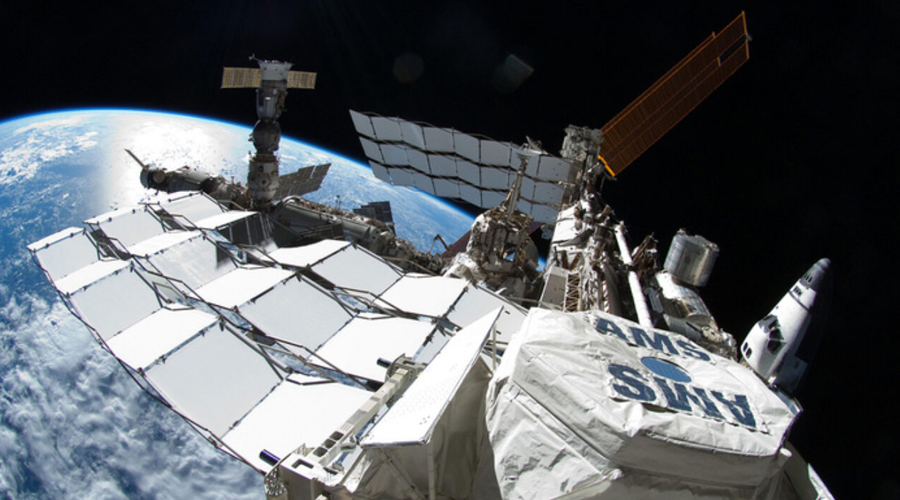 In five years, the Alpha Magnetic Spectrometer (AMS) has observed more than 90 billion cosmic particles, including over a million rare antimatter particles, and undertaken a systematic study of all the nuclear species in cosmic rays, discovering surprising information about the characteristics of the spectra of protons, helium and lithium. The great antimatter hunter has thus opened up a new era of high-precision measurements for particle physics research in space and new and more in-depth theories are now required to explain these observations. The Nobel Prize winner Samuel C.C. Ting from the MIT provided a summary of these first results at a seminar at CERN in December.
In five years, the Alpha Magnetic Spectrometer (AMS) has observed more than 90 billion cosmic particles, including over a million rare antimatter particles, and undertaken a systematic study of all the nuclear species in cosmic rays, discovering surprising information about the characteristics of the spectra of protons, helium and lithium. The great antimatter hunter has thus opened up a new era of high-precision measurements for particle physics research in space and new and more in-depth theories are now required to explain these observations. The Nobel Prize winner Samuel C.C. Ting from the MIT provided a summary of these first results at a seminar at CERN in December.
AMS is an international collaboration, led by Mr. Ting, with participating institutions from 15 countries across three continents. Italy has made a fundamental contribution: most of the detectors on board AMS were built in this country by teams at the INFN and the Universities involved (Bologna, Milan, Perugia, Rome Sapienza, Trento) and with the contribution of the main Italian aerospace companies, coordinated by the Italian Space Agency (ASI). AMS was carried into orbit in May 2011 by the STS-134 mission of the space shuttle Endeavour and installed on the ISS under an agreement between NASA and the DoE (Department of Energy). The experiment is run by collaboration members at the Payload Operations Control Centre at CERN, who work in close partnership with the NASA support team at the Johnson Space Centre. All data obtained by the experiment are sent to the National Computing Centre (CNAF) of the INFN to be analysed before being forwarded to the ASI Science Data Centre (ASDC).
The mission's main purpose is to study antimatter particles: AMS studies the spectral shape of cosmic ray positrons and antiprotons in an unexplored energy range.
Extremely small amounts of antimatter particles may be created as cosmic ray particles collide with interstellar dust, but it is possible that the excess of antimatter particles observed, compared to that expected from a "standard" production, might be linked to the presence of new exotic sources, such as annihilations of dark matter particles. This represents a huge experimental challenge: 10,000 protons, 1,000 helium nuclei and 100 electrons have to be "rejected" to observe one antiproton. This was made possible by simultaneously using several detection techniques developed via high energy physics experiments in particle accelerators. AMS has measured proton and antiproton fluxes in a wide energy range never previously achieved, and studied the different characteristics of their particle spectra. An excess was detected in both channels compared to the expected rate, confirming the observations of Pamela in 2009, but to a higher degree of precision and in a wider energy range. New sources of antimatter particles and/or new processes for generating these antimatter particles in the interstellar medium are required to explain these observations. Alternatively, astrophysical sources, such as pulsars, represent a "conventional" source that could explain the observations of AMS.
Another mystery surrounding antimatter being investigated by AMS concerns the origins of the universe: according to the Big Bang theory, matter and antimatter should have been created in equal amounts, but the universe as we know it is made of matter, and we have yet to understand why. Observing even just one antimatter nucleus in the cosmic rays, such as antihelium or anticarbon, would thus be extremely important. In five years, AMS has collected 3.7 billion helium events with an electric charge of Z=+2, and a few Z=-2 events with a mass of around 3He, which could thus represent possible antihelium candidates. The signal (antihelium) to background (helium) ratio is extremely small in these observations, around 1/1 billion: to fully understand these events it is hence fundamental to comprehend and take into account the influences of instrumental effects.
At a required signal (antihelium) to background (helium) rejection rate of around just one in a billion, an extremely detailed understanding of the instrument is required to establish the exact nature of these events. AMS has also begun a systematic study of all the nuclear species in cosmic rays, ranging from the lightest, such as protons, helium and lithium, to heavier nuclei up to iron, presenting its results up to oxygen nuclei. The large amount of statistical data collected and the precision of AMS detectors have provided unexpected information about the characteristics of the spectra of proton, helium and lithium, and the different behaviour of "primary" species, produced by sources, and "secondary" ones mainly produced in collisions with the interstellar medium. The interpretation of these measurements is directly linked to the mechanisms that produce cosmic rays and the processes that affect their path as they travel through the Galaxy and define the length of their journey according to the flux ratios between the different species.
If we are to fully understand the phenomena observed by AMS in the field of cosmic ray physics, distinguish between the different scenarios to account for the excesses of antimatter particles observed and confirm the possible antihelium candidates, the experiment must continue to gather data in the coming years, for as long as the ISS stays in orbit.






